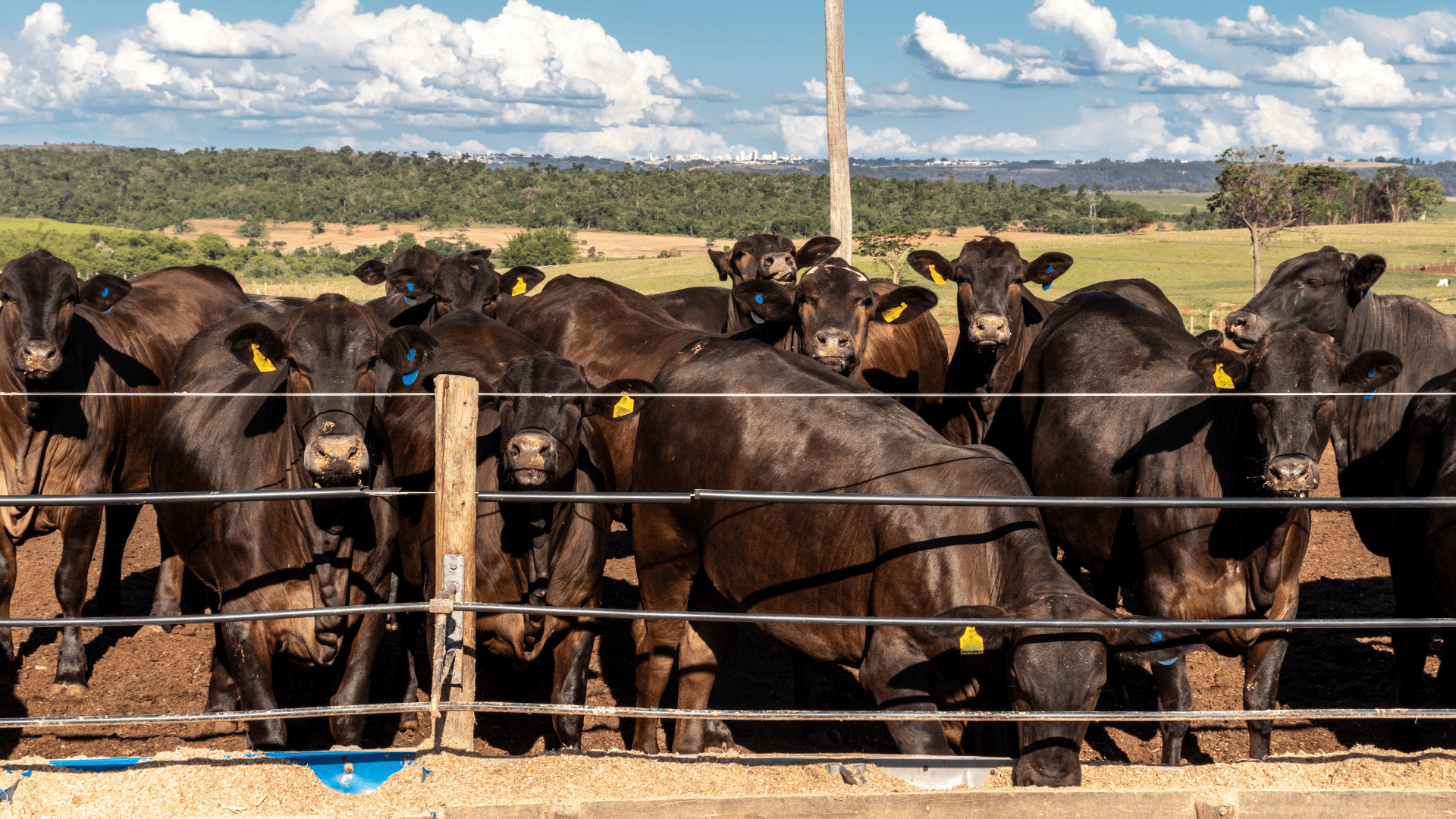Ascorbic acid (Vitamin C) – Broiler nutrition
Ascorbic acid Ascorbic acid, commonly called vitamin C, refers to compounds that exhibit L-ascorbic acid activity and is part of the group of water-soluble vitamins. […]
- 21/07/2021
- ler mais...

Vitamins are complex molecules found naturally or artificially in foods or as precursors to them. They are part of several metabolic processes and are required in minimal amounts for the proper functioning of the organism. In their absence, specific symptoms and deficiency diseases can be observed, corrected soon after the correct supplementation.
Vitamins A / D / E belong to the fat-soluble group, in which vitamin K is still found, thus forming the acronym ADEK. They have lipid-like absorption and are usually storable in the same locations as lipids. Unlike the water-soluble group, vitamins A / D, if supplemented in excess, have toxicity.
In practice, it is considered the most important vitamin to be supplemented for beef and dairy cattle. Some of the main functions of vitamin A are the Production of rhodopsin (vision pigment), maintenance of skeletal and epithelial tissue cells, spermatogenesis, and cell differentiation.
Vitamin A does not occur in plants, but vegetables are rich in precursors, carotenes. Some examples are B-carotenes, Alpha-carotenes, y-carotenes, and cryptoxanthin. These molecules are known as provitamin A because they are transformed into an active form in the animal organism.
B-carotenes are the most important provitamins A since almost every molecule absorbed is converted to retinal which is reduced to retinol. Some unconverted B-carotenes are absorbed intact and act as pigments for meat, eggs, milk, and fats.
Some problems due to disability:
Animals confined to a diet based on corn and silage have higher vitamin A requirements per unit weight. Grazing animals may also be deficient as a result of forage quality. Newborn calves do not have a reserve, and the consumption of colostrum is important. If the cow’s diet has low vitamin values, colostrum will also have smaller amounts.
Vitamin D is the generic name that includes ergocalciferol (D2) and cholecalciferol (D3). D2 is synthesized from the steroid ergosterol, present in vegetables, fungi, and yeasts. D3, on the other hand, is considered the natural form present in animal tissues and can be formed under the skin by the action of solar radiation. Both forms have similar activities and can be supplemented.
The primary function of this vitamin is linked to the transport and absorption of calcium in the intestine, and failure in the mineralization of Ca and P can cause deficiencies such as rickets and osteomalacia.
Vitamin D deficiency reduces the ability to maintain calcium and phosphorus homeostasis, resulting in a decline in plasma phosphorus and, less often, a reduction in plasma calcium. This finally leads to the development of rickets in young animals and osteomalacia in adults; both are bone diseases, in which the main lesion is the inability to mineralize the organic matrix of the bone. In young animals, rickets causes enlarged and painful joints; the costochondral joints of the ribs are often easily palpable. In adults, lameness and pelvic fracture are common sequelae of vitamin D deficiency.
In the case of dairy farming, the biggest problem encountered with vitamin D deficiency is the so-called milk fever.
We have an article about vitamin E here on our blog, soon we will focus on the benefits and deficiency part of ruminants.
Vitamin E is linked to antioxidant activity, acting together with selenium in defense of vital phospholipids. Additional vitamin E supplementation in dairy cows during the peripartum period has shown positive results in the functions of macrophages and neutrophils, reducing the incidence of mastitis and reproductive problems.
Its supplementation in beef cattle increases the levels of alpha-tocopherol in the tissues, reducing the percentage of metmyoglobin in the muscle and the concentrations of free radicals in the meat.
Some problems due to disability:
Deficiency is linked to inadequate intake, dry pastures, poor quality food, accelerated growth rates, and overuse of unsaturated fats.
Access our LinkedIn: OPTA Alimentos
Ascorbic acid Ascorbic acid, commonly called vitamin C, refers to compounds that exhibit L-ascorbic acid activity and is part of the group of water-soluble vitamins. […]
At the end of the last article entitled – Relationship between Clostridium perfringens and the immune system of broilers – it was said that a […]
Diagnosing risks and controlling critical points in the production process of feeds and mineral supplements is an essential tool for improving factory operations. Through these […]
Aquaculture and shrimp farming in Brazil have gained prominence due to their high production potential, driven primarily by the continent’s abundant water resources and favorable […]
Dietary fiber is an important component of the raw materials used in the production of feeds for the monogastric market. It is primarily found in […]
It has been proven that the broiler intestinal health plays a crucial role in sustainable production, directly impacting the well-being and efficient performance of these […]
The health of the sow plays a crucial role in the development and performance of piglets, influencing various aspects from gestation to the postnatal period. […]
Tannins are a heterogeneous group of polyphenolic polymers distinguishable into three main groups: hydrolyzable tannins (HTs), condensed tannins (CTs), and flavotannins (FTs). HT and CT […]
In industry, propionic acid is commonly used as a food and feed preservative and as a crucial chemical intermediate in the synthesis of cellulose fibers, herbicides, perfumes, cosmetics, colorants, artificial fruit flavors, esters used as solvents, plasticizers, rubber products, and pharmaceuticals. Below are some of the diverse industrial applications of Propionic Acid.
Ammonium chloride in animal production is used as an economical alternative to other inputs, such as urea in cattle diets. However, its applications are not limited to this, so let’s first understand what this compound is to better discuss its uses.
Wheat is a winter cereal from the Poaceae family with a millennia-long presence in the traditions, food security, and economic stability of people around the […]
Impact of Traceability on Consumers’ Daily Lives Grains are important sources of nutrients for people around the world. They can be used in their natural […]
The study of tannins, their applications, and their benefits to animals is advancing vigorously, opening horizons that involve nutritional strategies and the concept of one […]
1) Greater automation and process control: Dosing systems are usually composed of a tank, which can be installed outside the factory premises, saving internal space. […]
Nutritional and technological additives in balanced diets have been one of the most developed fronts in animal production chains nowadays. Many of these additives are […]
The search for sustainable production combined with the highest levels of quality demand by consumers is a challenge that nutritionists have strongly embraced. The production […]
Clostridium perfringens (CP) is a Gram-positive, spore-forming, anaerobic bacterium that is widely distributed in nature and commonly found in soil, dust, animal production sites such […]
Methanic acid, popularly known as formic acid, was obtained for the first time in 1500, through a steam-drag distillation of solutions containing ants, a process […]
Feed Production Scenario Brazilian agricultural production, influenced by high commodity prices and several other factors such as the appreciation of the dollar and the heating […]
To keep up with the movement of an increasingly demanding market, where consumers are always looking for the best products and services, organizations need to […]
For years, the interactions between animal nutrition, hence well-nourished animals, and reproduction, have been studied. And there is scientific evidence that reproduction is compromised when […]
The world is undergoing intense transformations since the popularization and facilitation of access to information. This rapid globalization caused outdated industries within this context to […]
We have already superficially addressed the problems related to the use of antibiotics as growth promoters. Consequently, we talked a little about possible alternatives such […]
Conjugated linoleic acid – CLA is found naturally in many products. It was originally discovered as an anti-cancer component. The largest natural source comes from […]
Antinutritional factors are substances that, even in a vestigial state, reduce or prevent the use of a nutritional element. These antinutritional factors are mostly secondary […]
First of all, several mineral elements are essential for the growth, reproduction, and health of animals. Those required in larger quantities are called Macrominerals. Within […]
Vitamins are complex molecules found naturally or artificially in foods or as precursors to them. They are part of several metabolic processes and are required […]
Choline (Pure) is an organic compound belonging to the group of quaternary ammonium salts, being chemically called 2-hydroxyethyl-trimethylammonium. Known as a B-complex vitamin, it does […]
In pig production, weaning piglets is a critical moment that requires a lot of attention. In the meantime, the animals are relocated in new lots, […]
Vitamin D belongs to the group of fat-soluble vitamins, and many consider it a hormone due to its functions. Its main role is linked to […]
Among meat-producing animals, chickens stand out for their higher GMD, in terms of body weight and the best feed conversion, being considered a relatively sustainable […]
Mathematical modeling is the art of correlating attributes of an application area in treatable mathematical formulas, whose theoretical and numerical operational analyzes provide useful insights, […]
Tannins are substances resulting from secondary, or special, metabolism of plants, and for a long time, it was seen as an anti-nutritional factor present in […]
Animal nutrition is constantly advancing to keep up with all the demand for animal protein and more sustainable production. According to data from FAO (Food […]
Essential oils (EOs) are extracted from plants through the technique of steam dragging, the vast majority of times, and also by pressing the pericarp of […]
Organic acids are substances that have a carboxylic group. In recent years, attention has been given to them as alternative additives to antibiotics, acting as […]
With the crisis of the new coronavirus (SARS-CoV-2), the eyes of the world have turned again to animal production. Having drawn attention to health issues. […]
DDGS (distillery and soluble dry grains) is a co-product of the production of corn-based ethanol, and much has been said about it in recent years, […]
